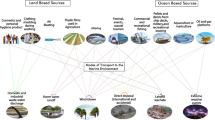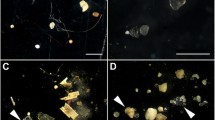Abstract
Polycyclic aromatic hydrocarbon (PAH) biota-sediment accumulation factors (BSAF) were quantified in sediments from two sites in southeastern Louisiana in a 14 d microcosm study usingPalaemonetes pugio, andRangia cuneata and two radiolabeled PAHs, phenanthrene and benzo[a]pyrene (b[a]p). For both PAHs studied, mean BSAFs were significantly higher (p<0.0001) in both organisms in sediments from Bayou Trepagnier, (BSAF=0.628 g OC g TLE−1), a brackish swamp, compared to Pass Fourchon (0.065 g OC g TLE−1), a coastal salt marsh. In order to explain observed patterns in BSAFs, organic carbon-normalized PAH distribution coefficients between the sediment and freely dissolved phases (KOC)OBS were determined as well as the various geochemical variables of particulate and dissolved organic matter (POM and DOM, respectively). These included analyses of particle surface area, total organic carbon (TOC), carbon to nitrogen ratios (C∶N), and dissolved organic carbon (DOC). Bayou Trepagnier was higher in surface area, TOC, C∶N, as well as DOC suggesting that the difference in BSAFs may be attributed to compositional differences in POM and DOM between sites. We can not exclude the possibility that other factors (such as differences in organism behavior resulting from contrasting sediment characteristics) were responsible for BSAFs varying between the two sites. Phenanthrene BSAFs were typically higher than b[a]p BSAFs, suggesting contaminants were limited in their desorption from sediment particles as a function of PAH molecular weight. Mean BSAFs for both PAHs were higher on Day 7 than on Day 14. The reason for this decrease is unclear, but did not appear to be due to organisms becoming increasingly stressed in the microcosms. Visual observations indicated that animals remained feeding while no decreases in organism total lipid levels were detected. The trends in BSAFs between sites and over the time course of this experiment suggest that contaminant bioaccumulation in estuarine systems should not be considered to be an equilibrium process.
Similar content being viewed by others
Literature Cited
Adams, W. J. 1987. Bioavailability of neutral lipophilic organic chemicals contained in sediments: A review, p. 219–244.In K. L. Dickson, A. W. Maki, and W. A. Brungs (eds.), Fate and Effects of Sediment-Bound Chemicals in Aquatic Systems. Pergamon Press, New York.
Baumard, P., H. Budzinski, P. Garrigues, H. Dizer, andP. D. Hansen. 1999. Polycyclic aromatic hydrocarbons in recent sediments and mussels (Mytilus edulis) from the Western Baltic Sea: Occurrence, bioavailability, and seasonal variations.Marine Environmental Research 47:17–47.
Bligh, E. G. andW. J. Dyer. 1959. A rapid method of total lipid extraction and purification.Canadian Journal of Biochemical Physiology 37:911–917.
Burgess, R. M. andR. A. McKinney. 1999. Importance of interstitial, overlying water, and whole sediment exposures to bioaccumulation by marine bivalves.Environmental Pollution 104:373–382.
Carman, K. R., J. C. Means, andS. Pomarico. 1996. Response of sedimentary bacteria in a Louisiana salt marsh to contamination by diesel fuel.A quatic Microbial Ecology 10:231–241.
Connell, D. 1997. Basic Concepts of Environmental Chemistry. Lewis Publishing, Boca Raton, Florida.
Dickhut, R. M. andK. L. Gustafson. 1995. Atmospheric inputs of selected polycyclic aromatic hydrocarbons and polychlorinated biphenyls to southern Chesapeake Bay.Marine Pollution Bulletin 30:385–396.
DiToro, D. M., C. S. Zarba, D. J. Hansen, W. J. Berry, R. C. Swartz, C. E. Cowan, S. P. Pavlou, H. E. Allen, N. A. Thomas, andP. R. Paquin. 1991. Technical basis for establishing sediment quality criteria for nonionic organic chemicals using equilibrium partitioning.Environmental Toxicology and Chemistry 10:1541–1583.
Flowers, G. C., J. N. Suhayda, J. W. Clymire, G. L. McPherson, L. V. Koplitz, andM. A. Poirrier. 1998. Impact of industrial effluent diversion on Bayou Trepagnier, Louisiana.Environmental and Engineering Geoscience 4:77–91.
Freidig, A. P., E. A. Garicano, F. J. M. Busser, andJ. L. M. Hermens. 1998. Estimating impact of humic acid on bioavailability and bioaccumulation of hydrophobic chemicals in guppies using kinetic solid-phase extraction.Environmental Toxicology and Chemistry 17:998–1004.
Gauthier, T. D., W. R. Seitz, andC. Grant. 1987. Effects of structural and compositional variations of dissolved humic materials on pyrene KOC values.Environmental Science and Technology 21:243–248.
Gelboin, H. 1980. Benzo [a] pyrene metabolism, activation, and carcinogenesis: Role and regulation of mixed function oxidases and related enzymes.Physiological Reviews 60:1107–1166.
Green, S. A. andN. V. Blough. 1994. Optical absorption and fluorescence properties of chromophoric dissolved organic matter in natural waters.Limnology and Oceanography 39:1903–1916.
Gregg, S. J. andK. S. W. Sing. 1982. Adsorption, Surface Area, and Porosity. Academic Press, New York.
Gunnarsson, J. S., K. Hollertz, andR. Rosenberg. 1999. Effects of organic enrichment and burrowing activity of the polychaeteNereis diversicolor on the fate of tetrachlorobiphenyl in marine sediments.Environmental Toxicology and Chemistry 18:1149–1156.
Haitzer, M., S. Hoss, W. Traunspurger, andC. Steinberg. 1998. Effects of dissolved organic matter (DOM) on the bioconcentration of organic chemicals in aquatic organisms: A review.Chemosphere 37:1335–1362.
Harkey, G. A., M. J. Lydy, J. Kukkonen, andP. Landrum. 1994. Feeding selectivity and assimilation of PAH and PCB inDiporeia spp.Environmental Toxicology and Chemistry 13:1445–1455.
James, M. O. 1989. Biotransformation and disposition of PAH in aquatic invertebrates, p. 69–91.In U. Varanasi (ed.), Metabolism of Polycyclic Aromatic Hydrocarbons in the Aquatic Environment. CRC Press, Boca Raton, Florida.
Knezovich, J. P., F. L. Harrison, andR. G. Wilhelm. 1987. The bioavailability of sediment-sorbed organic chemicals: A review.Water, Air, and Soil Pollution 32:233–245.
Kukkonen, J. andP. F. Landrum. 1994. Toxicokinetics and toxicity of sediment-associated pyrene toLumbriculus variegatus (Oligochaeta).Environmental Toxicology and Chemistry 13:1457–1468.
Kukkonen, J. andA. Oikari. 1991. Bioavailability of organic pollutants in boreal waters with varying levels of dissolved organic material.Water Research 25:455–463.
Landrum, P. F.. 1989. Bioavailability and toxicokinetics of polycyclic aromatic hydrocarbons sorbed to sediments for the amphipodPontoporeia hoyi.Environmental Science and Technology 23:588–595.
Landrum, P. F., M. D. Reinhold, S. R. Nihart, andB. J. Eadie. 1985. Predicting the bioavailability of organic xenobiotics toPontoporeia hoyi in the presence of humic and fulvic materials and natural dissolved organic matter.Environmental Toxicology and Chemistry 4:459–467.
Lay, P. W. 1996. Demersal predator exposure to toxic organic contaminants: Direct effects of macrofauna in trophic transfer. Ph.D. Dissertation, Virginia Institute of Marine Science, School of Marine Science, College of William and Mary. Gloucester Point, Virginia.
Leppanen, M. T. andJ. V. K. Kukkonen. 1998. Relative importance of ingested sediment and porewater as bioaccumulation routes for pyrene to oligochaete (Lumbriculus variegatus, Miller).Environmental Science and Technology 32:1503–1508.
Li, T. 1996. Lipid class composition of oysters,Crassostrea virginica, exposed to sediment-associated PAHs. M.S. Thesis, Virginia Institute of Marine Science, School of Marine Science, College of William and Mary. Gloucester Point, Virginia.
Madureira, M. J., A. M. Picado, A. M. Ferriera, E. Mendonca, Y. Le Gal, andC. Vale. 1993. PCB contamination in the oysterCrassostrea angulata: Effects on lipids and adenylic energetic change.The Science of the Total Environment Supplement 1993:599–605.
Maruya, K. A. andR. F. Lee. 1998. Biota-sediment accumulation and trophic transfer factors for extremely hydrophobic polychlorinated biphenyls.Environmental Toxicology and Chemistry 17:2463–2469.
Maruya, K. A., R. A. Risebrough, andA. J. Horne. 1997. The bioaccumulation of polynuclear aromatic hydrocarbons by benthic invertebrates in an intertidal marsh.Environmental Toxicology and Chemistry 16:1087–1097.
Mayer, L. 1994. Surface area control of organic carbon accumulation in continental shelf sediments.Geochimica et Cosmochimica Acta 58:1271–1284.
Mayer, L., Z. Chen, R. Findlay, J. Fang, S. Sampson, L. Self, P. Jumars, C. Quetel, andO. Donard. 1996. Bioavailability of sedimentary contaminants subject to deposit-feeder digestion.Environmental Science and Technology 30:2641–2645.
McCarthy, J. F., L. E. Roberson, andL. W. Burrus. 1989. Association of benzo[a]pyrene with dissolved organic matter: Prediction of KDOM from structural and chemical properties of the organic matter.Chemosphere 19:1911–1920.
McGroddy, S. E. andJ. W. Farrington. 1995. Sediment porewater partitioning of polycyclic aromatic hydrocarbons in three cores from Boston Harbor, Massachusetts.Environmental Science and Technology 29:1542–1550.
McMurthy, M. J., D. J. Rapport, andK. E. Chau. 1983. Substrate selection by tubificid oligochaetes.Canadian Journal of Aquatic Sciences 40:1639–1646.
Mitra, S., R. M. Dickhut, S. A. Kuehl, andK. L. Kimbrough. 1999. Polycyclic aromatic hydrocarbon (PAH) source, sediment deposition patterns, and particle geochemistry as factors influencing PAH distribution coefficients in sediments of the Elizabeth River, VA, USA.Marine Chemistry 66:113–127.
National Research Council. 1983. Polycyclic Aromatic Hydrocarbons: Evaluation of Sources and Effects. National Academy Press, Washington, D.C.
Neff, J. M. andJ. W. Anderson. 1981. Response of Marine Animals to Petroleum and Specific Petroleum Hydrocarbons. Applied Science Publishers Ltd, London.
Rabalais, N. N., B. A. McKee, D. J. Reed, andJ. C. Means. 1991. Fate and Effects of Nearshore Discharges of OCS Produced Waters, Volume III. Appendices. OCS Study/MMS 91-0006. U.S. Department of the Interior, Minerals Management Service, Gulf of Mexico, OCS Regional Office, New Orleans, Louisiana.
Rutherford, D. W., C. T. Chiou, andD. Kile. 1992. Influence of soil organic matter composition on the partitioning of organic compounds.Environmental Science and Technology 26:336–340.
Schaffner, L. C., R. M. Dickhut, S. Mitra, P. W. Lay, andC. Brouwer-Reil. 1997. Effects of physical chemistry and bioturbation by estuarine macrofauna on the transport of hydrophobic organic contaminants in the benthos.Environmental Science and Technology 31:3120–3125.
Schwarzenbach, R. P., P. M. Gschwend, andD. M. Imboden. 1993. Environmental Organic Chemistry. John Wiley & Sons, Inc., New York.
Shiaris, M. P. 1989. Seasonal biotransformation of naphthalene, phenanthrene, and benzo[a]pyrene in surficial estuarine sediments.Applied and Environmental Microbiology 55:1391–1399.
Standley, L. J. 1997. Effect of sedimentary organic matter composition on the partitioning and bioavailability of dieldrin to the oligochaeteLumbriculus variegatus.Environmental Science and Technology 31:2577–2583.
Thomann, R. V. andJ. Komlos. 1999. Model of biota-sediment accumulation factor, for polycyclic aromatic hydrocarbons.Environmental Toxicology and Chemistry 18:1060–1068.
Tracey, G. A. andD. J. Hansen. 1996. Use of biota-sediment accumulation factors to assess similarity of non-ionic organic chemical exposure to benthically-coupled organisms of differing trophic mode.Archives of Environmental Contamination and Toxicology 30:467–475.
Weber, Jr.W. J., P. M. McGinley, andL. E. Katz. 1992. A distributed reactivity model for sorption by soils and sediments. 1—Conceptual basis and equilibrium assessments.Environmental Science and Technology 26:1955–1962.
Author information
Authors and Affiliations
Corresponding author
Rights and permissions
About this article
Cite this article
Mitra, S., Klerks, P.L., Bianchi, T.S. et al. Effects of estuarine organic matter biogeochemistry on the bioaccumulation of PAHs by two epibenthic species. Estuaries 23, 864–876 (2000). https://doi.org/10.2307/1353003
Received:
Accepted:
Issue Date:
DOI: https://doi.org/10.2307/1353003




